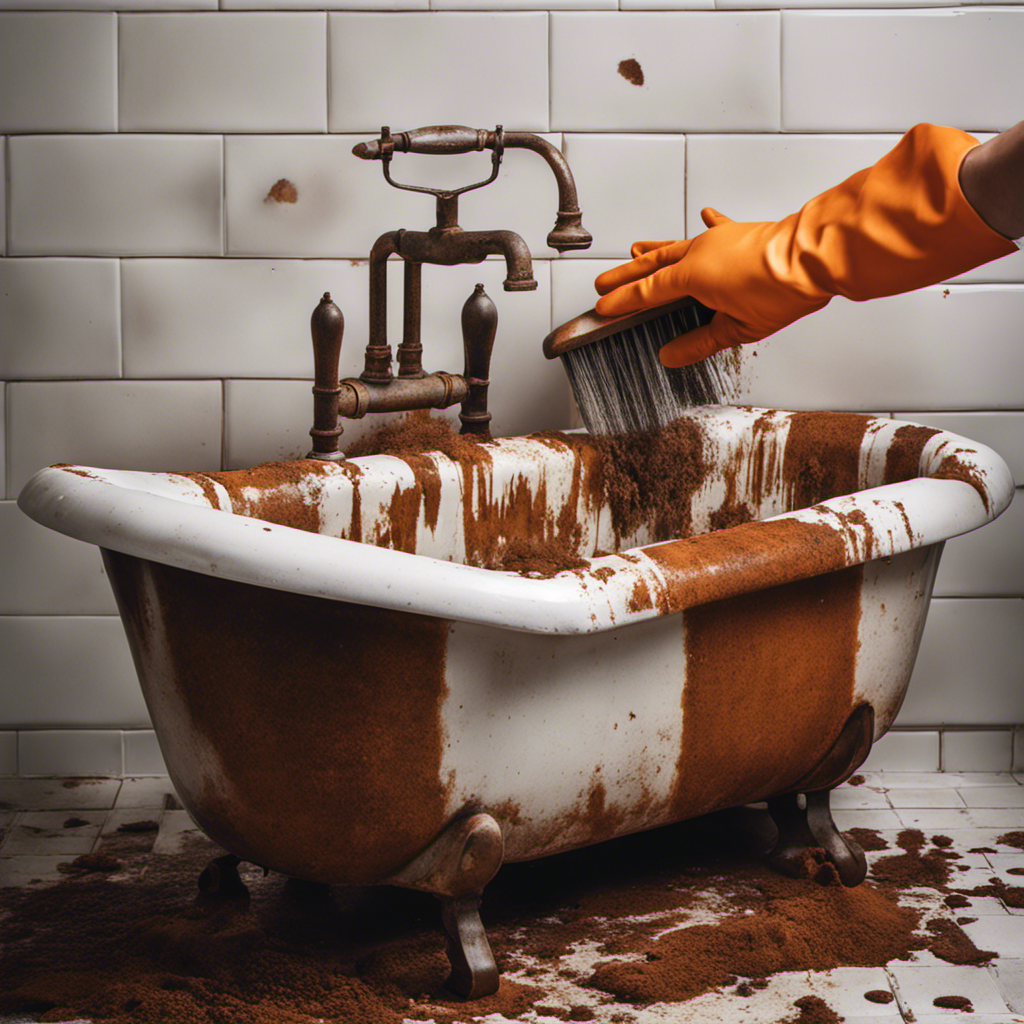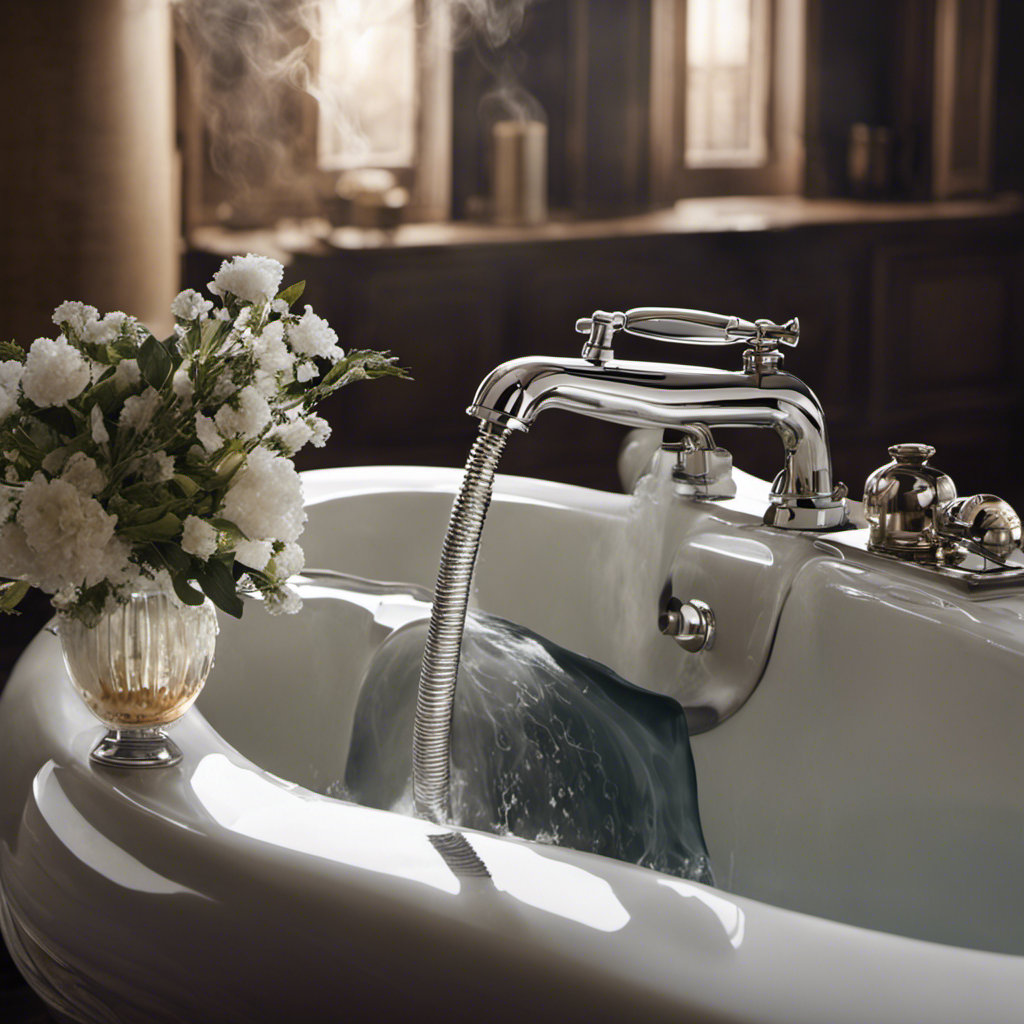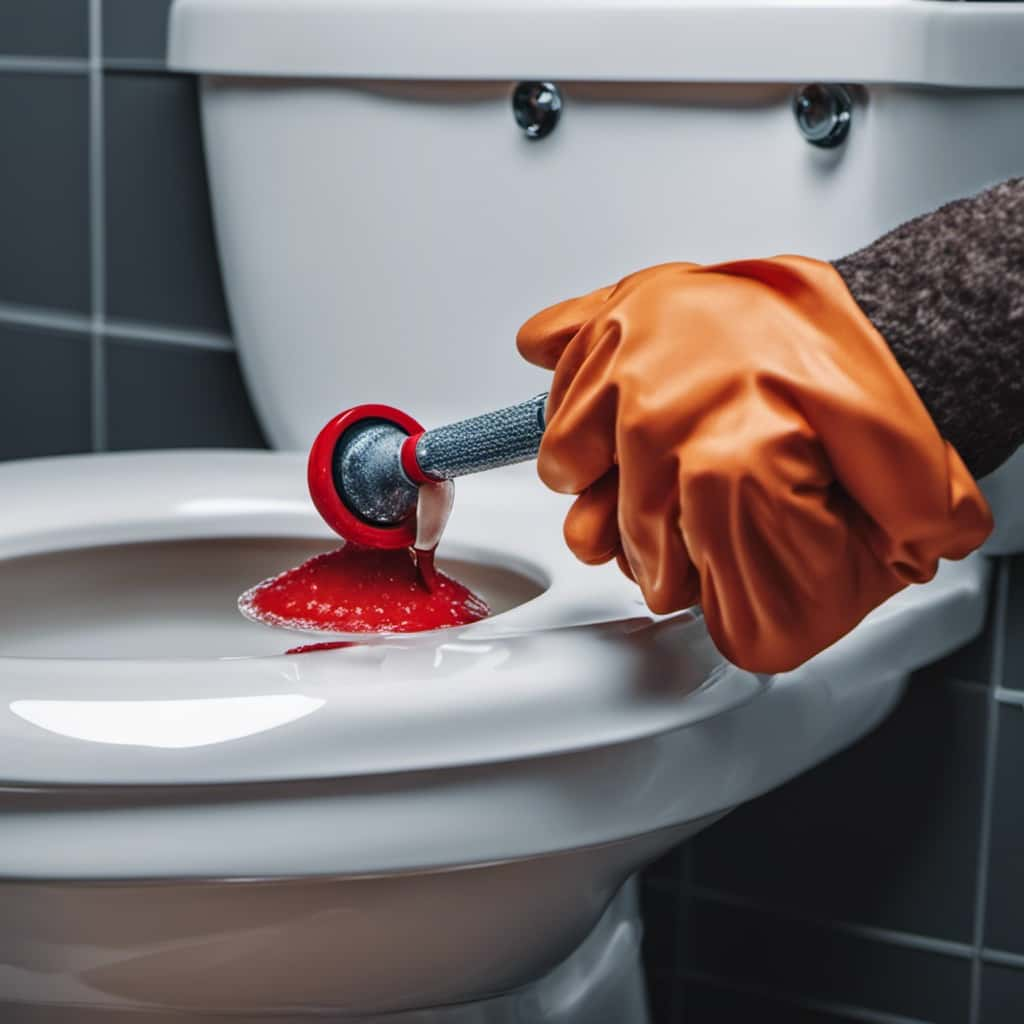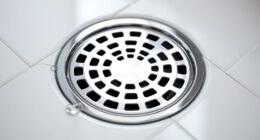Did you know that over time, bathtubs can develop unsightly rust? If you’re like me and want to restore your bathtub to its former glory, then you’re in the right place.
In this article, I’ll guide you through the step-by-step process of fixing a rusty bathtub. We’ll start by assessing the extent of the rust and gathering the necessary tools and materials.
Then, we’ll remove the rust from the bathtub surface and prepare it for repair. Finally, we’ll apply a rust-resistant coating or paint to ensure long-lasting results.
Let’s get started!
Key Takeaways
- Assess the extent of the rust and identify signs of rust progression.
- Gather all the necessary tools and materials before starting the repair process.
- Use natural rust removers like white vinegar or lemon juice to remove rust from the bathtub surface.
- Properly prepare the bathtub surface by removing debris, cleaning it thoroughly, and creating a better bonding surface before repair.
Assess the Extent of the Rust
Now, you’ll want to take a close look at the bathtub to see just how much rust there is. To prevent bathtub rust, it’s crucial to identify the signs of rust progressing.
Start by examining the surface of the bathtub for any discoloration or rough spots. These can be an indication of rust beginning to form. Additionally, check for any small cracks or chips in the enamel coating, as these can expose the underlying metal to moisture and facilitate rusting.
Pay attention to any areas where the paint or enamel has peeled off, as this can also contribute to rust development. By thoroughly assessing the extent of the rust and identifying the signs of progression, you can take the necessary steps to fix a rusty bathtub effectively.
Gather the Necessary Tools and Materials
In order to successfully repair a bathtub, it is crucial to have the essential tools needed for the job. These tools may include a putty knife, sandpaper, a caulking gun, and a paintbrush, among others.
Additionally, gathering the necessary materials is essential for a thorough and lasting repair. These materials may include epoxy filler, bathtub repair paint, and caulk.
Having the right tools and materials will ensure that the bathtub repair is done properly and will last for a long time.
Essential Tools Needed
First, you’ll need a few essential tools to fix a rusty bathtub. Here are the three items you’ll need:
-
Wire brush: This tool is essential for removing rust and other debris from the surface of the bathtub. The wire bristles are strong enough to scrub away the rust without damaging the tub’s finish.
-
Sandpaper: Once the rust is removed, sandpaper is needed to smooth out any rough spots on the surface. Choose a fine-grit sandpaper to avoid scratching the tub.
-
Rust converter: After cleaning and sanding the rusty areas, it’s important to treat the surface with a rust converter. This product chemically converts the remaining rust into a stable compound, preventing further corrosion.
Materials for Bathtub Repair
To repair your bathtub, you’ll need to gather a few necessary materials. The materials required for bathtub repair are readily available and can save you significant costs compared to replacing the entire bathtub.
The bathtub repair cost can vary depending on the extent of the damage and the materials used. However, in most cases, repairing the bathtub is a more cost-effective option compared to replacement. By repairing the bathtub, you can restore its functionality and appearance without breaking the bank.
Now that you understand the cost benefits of bathtub repair, let’s move on to the next step: gathering supplies and equipment.
Gathering Supplies and Equipment
You’ll need to make sure you have all the necessary supplies and equipment for the bathtub restoration. Here are three key items you’ll need for the rust removal process:
-
Protective gear: Safety should always come first. Wear gloves, goggles, and a mask to protect yourself from any harmful chemicals or debris during the restoration process.
-
Rust remover solution: Look for a rust remover specifically designed for bathtubs. These solutions are usually acidic and can effectively dissolve rust without damaging the surface of the tub. Follow the instructions on the product label for the best results.
-
Scrubbing tools: To remove the rust, you’ll need the right tools. Nylon scrub brushes or steel wool can be used to scrub away the rusted areas gently. Make sure to choose the appropriate tool based on the severity of the rust.
Remove the Rust From the Bathtub Surface
Once the rust has been removed from the bathtub surface, it can be restored to its original condition.
Rust removal techniques are essential in bringing back the bathtub’s pristine appearance. There are various methods to eliminate rust, but I highly recommend using natural rust removers, as they are effective and safe for both you and the environment.
One popular natural rust remover is white vinegar. Simply soak a cloth in vinegar and scrub the rusty areas until the rust is gone.
Another option is lemon juice, which contains citric acid that can dissolve rust. Apply the juice onto the affected areas and let it sit for a few hours before scrubbing.
Prepare the Bathtub for Repair
First, make sure you have all the necessary tools and materials ready for repairing the bathtub.
To prepare the surface for repair, follow these three cleaning techniques:
-
Remove any loose debris: Use a stiff brush or a scraper to remove any loose rust or paint from the surface of the bathtub. This will ensure that the repair materials adhere properly.
-
Clean the surface thoroughly: Use a mild detergent or a bathtub cleaner to clean the entire surface of the bathtub. Scrub gently to remove any dirt, grime, or soap scum that may be present. Rinse the surface thoroughly with water and allow it to dry completely.
-
Sand the surface: Use a fine-grit sandpaper to lightly sand the surface of the bathtub. This will help to smooth out any rough spots and create a better surface for the repair materials to bond to.
Apply a Rust-Resistant Coating or Paint
When it comes to applying a rust-resistant coating or paint to a bathtub, it is crucial to consider the best options available in the market. The choice of coating can greatly impact the longevity of the painted surface, ensuring its durability and protection against rust.
In this discussion, I will explore the various coating options and their effectiveness in terms of providing a long-lasting solution for a painted bathtub surface.
Best Coating Options
To protect your rusty bathtub, consider using one of the best coating options available. Bathtub refinishing is a popular choice for homeowners who want to restore their tubs to their former glory.
Here are three top coating options to consider for your bathtub refinishing project:
-
Epoxy Coating: This durable and waterproof coating provides a high-gloss finish that can withstand daily use. It is resistant to chemicals and stains, making it an excellent choice for long-lasting protection.
-
Acrylic Urethane Coating: This coating offers excellent adhesion and durability. It provides a smooth and glossy finish that is resistant to chipping, peeling, and fading. It also offers good resistance to chemicals and stains.
-
Porcelain Enamel Coating: This coating is designed to mimic the look and feel of porcelain. It is highly durable, resistant to scratches, and provides a glossy finish. It is an ideal choice for a vintage or classic bathtub restoration.
By using one of these professional restoration services, your bathtub can have a beautiful and long-lasting finish. This will not only protect your tub from further rusting but also enhance its overall appearance.
Now, let’s discuss the longevity of the painted surface.
Longevity of Painted Surface?
If you want your painted surface to last for a long time, make sure to properly clean and maintain it on a regular basis. Protective measures are crucial to ensure the longevity of your painted surface. One alternative solution is to apply a clear coat or protective sealant over the paint. This creates an additional barrier against external elements such as moisture, UV rays, and dirt. Another option is to use paint with built-in protective properties, such as those containing additives like UV blockers and rust inhibitors. These additives help to prolong the lifespan of the paint by providing extra protection against the damaging effects of the environment. By implementing these protective measures and exploring alternative solutions, you can greatly extend the life of your painted surface and enjoy its beauty for years to come.
| Protective Measures | Alternative Solutions |
|---|---|
| Regular cleaning and maintenance | Apply a clear coat or protective sealant |
| Use paint with built-in protective properties | Explore additives like UV blockers and rust inhibitors |
Maintain the Bathtub to Prevent Future Rusting
You can prevent future rusting of your bathtub by regularly cleaning and drying it after each use. This simple maintenance routine will help to remove any moisture and prevent the formation of rust.
Here are three key steps to follow for effective bathtub maintenance:
-
Clean with a mild detergent: Use a non-abrasive cleaner and a soft cloth or sponge to gently scrub the bathtub surface. Avoid using harsh chemicals or abrasive scrubbers as they can damage the finish and increase the risk of rust.
-
Dry thoroughly: After cleaning, make sure to dry the bathtub completely. Use a clean towel or a squeegee to remove any remaining moisture. Pay special attention to the corners and edges where water can accumulate.
-
Apply a protective coating: Consider applying a rust-resistant coating to the bathtub surface. There are various products available in the market that can help to create a protective barrier and prevent rust formation.
Conclusion
In conclusion, fixing a rusty bathtub is a straightforward process that can be completed with the right tools and materials. By assessing the extent of the rust, removing it from the surface, and applying a rust-resistant coating or paint, you can restore your bathtub to its former glory.
However, some may argue that it is easier to replace a rusty bathtub rather than going through the repair process. While this may be true in some cases, repairing the tub can be a cost-effective solution that allows you to enjoy your bathtub for years to come.
So, why not give it a try and save yourself some money in the process?










